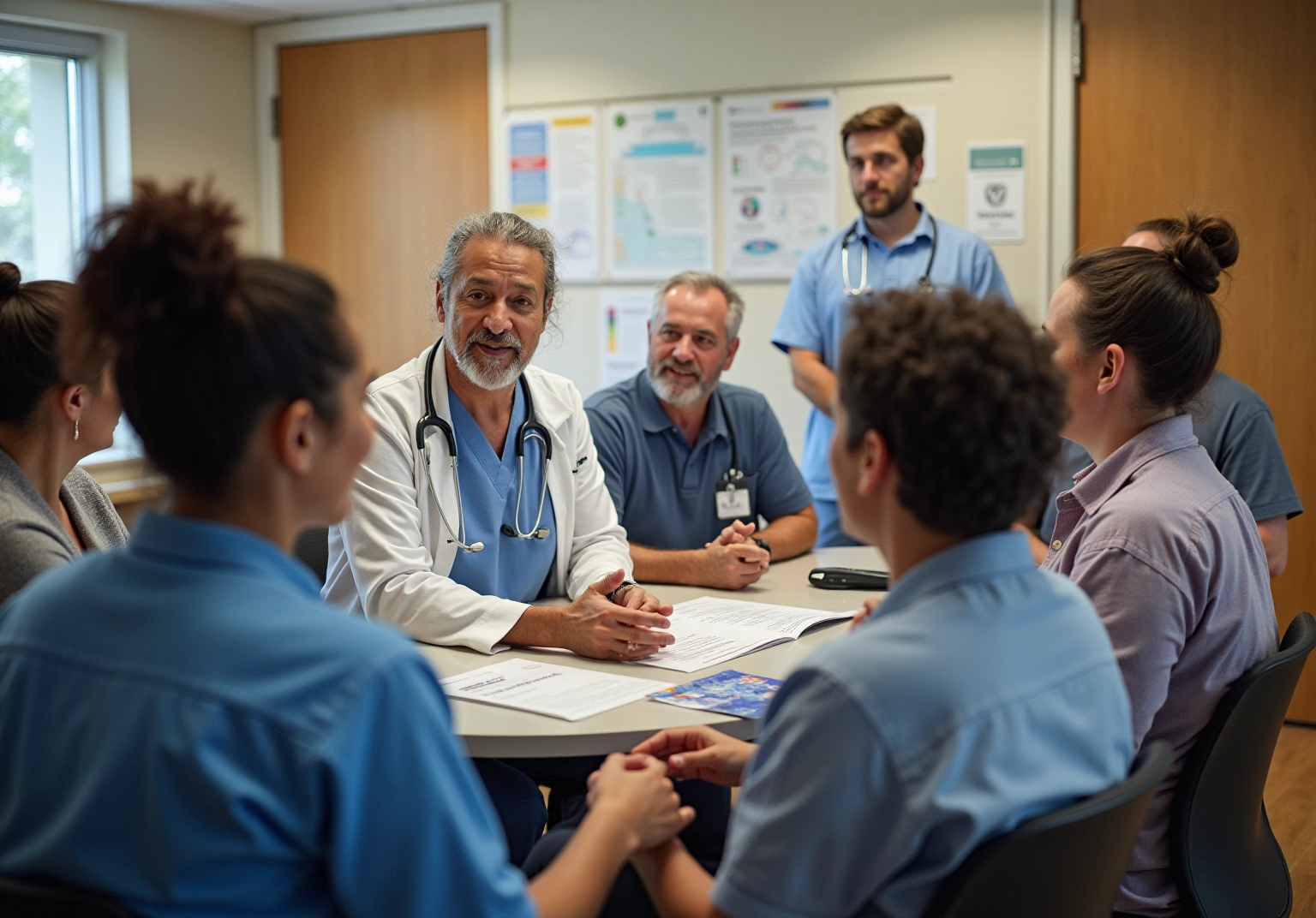
The article “9 Strategies to Close Care Gaps in Healthcare Delivery” primarily addresses the critical issue of disparities in healthcare access and quality. It explores effective methods to tackle these challenges, presenting various strategies such as:
These approaches collectively aim to enhance patient engagement, improve care coordination, and ensure that individuals receive timely and appropriate medical attention. Ultimately, these strategies work together to bridge existing care gaps, fostering a more equitable healthcare system.
In the dynamic realm of healthcare, addressing care gaps has become a paramount concern for providers dedicated to improving patient outcomes and optimizing operations. Innovative solutions like the Inferscience HCC Assistant and the Proactive Office Encounter model are revolutionizing the ways healthcare professionals interact with patients and manage chronic conditions. By harnessing advanced technologies and strategic frameworks, these initiatives not only enhance coding accuracy and care coordination but also empower patients through education and engagement.
As healthcare systems increasingly acknowledge the significance of tackling social determinants and embracing telehealth services, the emphasis on comprehensive patient care continues to intensify. This article explores various strategies and programs aimed at bridging care gaps, underscoring their importance in delivering effective and equitable healthcare within today’s intricate landscape.
The Inferscience HCC Assistant revolutionizes the collection and analysis of clinical data, delivering real-time coding recommendations at the point of treatment. This innovation not only alleviates the administrative burden on medical providers but also ensures that all relevant diagnoses are accurately documented, thereby improving Risk Adjustment Factor (RAF) scores. By conducting a gap analysis on claims files, the Claims Assistant identifies potentially overlooked HCC codes, thereby enhancing billing accuracy and compliance. This streamlined approach to HCC coding empowers healthcare providers to more effectively address the care gap, ensuring that patients receive the necessary attention and resources for their medical conditions.
Commencing January 1, 2026, the rollout of the Transforming Episode Accountability Model (TEAM) will further emphasize the critical nature of precise coding practices. Organizations that implement automated solutions such as the HCC Assistant can mitigate risks linked to claim denials and billing inaccuracies, as evidenced by case studies that highlight the challenges of retrospective risk adjustment. As ECLAT Health Solutions asserts, “To maintain good legal standing with CMS, best practices and ongoing internal and external vendor retrospective accuracy audits are essential.” CFOs who emphasize regular audits and staff training, in conjunction with utilizing Inferscience’s Claims Assistant, can markedly enhance coding accuracy and financial outcomes. This proactive strategy not only safeguards the financial health of medical systems but also elevates the quality of service delivered to patients.
The Proactive Office Encounter (POE) model emphasizes systematic engagement of individuals during office visits. By incorporating technology and standardized processes, medical teams can recognize and tackle the care gap in treatment during each individual interaction. This model promotes preventive measures, ensuring that individuals obtain essential screenings and interventions, ultimately resulting in enhanced health outcomes and lower medical expenses. For instance, implementing rounding practices, where providers regularly interact with individuals, enhances communication and demonstrates a commitment to person-centered care, leading to better experiences and outcomes.
Statistics indicate that improved involvement of individuals can result in a decrease in readmission rates by as much as 14%, underscoring the model’s potential effect on medical expenses. Moreover, organizations employing engagement analytics have reported remarkable returns on investment, with some attaining ROIs as high as 5.7:1. As we transition into 2025, the POE model is poised to play a vital role in healthcare delivery, highlighting the significance of prompt responses to inquiries from individuals receiving care. Notably, 58% of individuals under 55 and 63% of those over 55 consider rapid responses crucial for their satisfaction, emphasizing the model’s effectiveness in improving engagement.
Recent implementations of client engagement strategies, such as utilizing QR codes for feedback, have illustrated the effectiveness of the POE model in fostering involvement. By emphasizing preventive measures and increasing the involvement of individuals, the POE model not only enhances outcomes but also helps to close the care gap, enabling healthcare providers to offer more efficient and economical services.
Geisinger’s Keystone Accountable Care Organization (ACO) addresses a critical issue in healthcare: the care gap that highlights the need for improved service coordination. The Health Navigator program stands out as a robust solution, incorporating community support assistants who conduct home visits to assess individuals’ requirements and living situations. By effectively connecting clinical services with community resources, this initiative provides comprehensive support that not only enhances wellness outcomes but also significantly reduces hospital readmissions.
Notably, data from Geisinger indicates that individuals engaged with Health Navigators experience a remarkable 20% reduction in readmission rates, underscoring the program’s efficacy in fostering better wellness management. Furthermore, experts emphasize that genuine healing necessitates a dedicated commitment to individual well-being, highlighting the importance of such coordinated support initiatives in today’s healthcare landscape.
As Sara Vaezy aptly noted, the focus is less on merely adapting to the pandemic and more on leveraging our insights to propel the health system’s mission to assist all individuals more effectively, scalably, and equitably. Additionally, the challenges faced by organizations like Inspira Health in managing quality metrics across various value-based initiatives illustrate the care gap and the complexities of coordination in healthcare, further reinforcing the need for efficient programs like Geisinger’s Health Navigator.

The Chronic Care Management (CCM) initiative stands as a crucial solution for delivering ongoing support to individuals grappling with chronic conditions. By developing individualized treatment plans and ensuring consistent follow-ups, healthcare providers can effectively monitor the well-being of these individuals. This proactive approach not only aids in managing chronic conditions but also significantly mitigates the risk of acute medical emergencies.
Notably, medical systems that have successfully embraced CCM report heightened patient involvement and satisfaction, with research indicating that tailored treatment plans can enhance the effectiveness of practice methods. Furthermore, longitudinal data from regular monitoring facilitates informed decision-making, ultimately resulting in improved health outcomes.
Recent success stories, such as the hybrid strategy implemented by CrossTx, illustrate that the integration of technology and data analysis within CCM enhances the quality of support, thereby addressing the care gap and fostering a more responsive healthcare environment.

HealthHelper harnesses the power of artificial intelligence to meticulously analyze individual data, effectively identifying service gaps. These care gaps occur when individuals miss recommended evaluations or screenings, which can potentially lead to significant health risks. By automating the monitoring of client interactions and outcomes, HealthHelper empowers healthcare providers to concentrate on high-risk individuals who require additional support. This strategic focus not only boosts individual engagement but also facilitates timely interventions, ensuring that any care gap is promptly addressed.
Common causes of care gaps include:
These factors can hinder effective management of individuals. Through its innovative capabilities, HealthHelper exemplifies how AI can revolutionize engagement with individuals and strategies for addressing the care gap within the evolving medical landscape.

Telehealth services have revolutionized access to medical care, particularly for individuals in remote or underserved areas. By facilitating virtual consultations, medical providers can reach those who may face challenges in receiving treatment, such as transportation issues or mobility limitations. This enhanced access not only helps bridge the care gap but also promotes timely interventions, ultimately leading to improved health outcomes.
The impact of telehealth on addressing the care gap is underscored by compelling statistics; for instance, telehealth utilization has stabilized at 38 times higher than pre-pandemic levels, reflecting a substantial shift in healthcare delivery. Investments in telehealth skyrocketed to $4.2 billion in the first quarter of 2021, doubling the figure from the previous year, which demonstrates a robust commitment to expanding these services.
Case studies further exemplify the efficacy of telehealth. Research published in Critical Care Medicine indicated that the introduction of telehealth in ICU settings resulted in a reduction in hospital mortality rates from 13.8% to 11.8%, highlighting its beneficial impact on patient outcomes. Additionally, telemedicine has demonstrated an impressive average return on investment of $3.30 for every dollar spent, reinforcing its financial viability.
Expert perspectives further emphasize the importance of telehealth in addressing service gaps. Dr. Brayer, an internal medicine physician, observes that while telehealth offers significant advantages, it should not be utilized for certain conditions, such as recurrent chest pain or severe sprains. This underscores the necessity of appropriate application. The ability to conduct virtual consultations for routine follow-ups and non-urgent issues greatly enhances access to services, particularly for marginalized populations, where medical resources may be limited.
In summary, telehealth services are essential for addressing the care gap, ensuring that individuals receive prompt and effective medical attention, regardless of their location.
Medication Therapy Management (MTM) programs are essential for enhancing therapeutic outcomes by ensuring individuals adhere to their prescribed medication regimens. Through regular medication reviews and personalized counseling, healthcare providers can proactively identify and address barriers to adherence. This targeted approach not only improves patient well-being but also significantly reduces the risk of complications and hospitalizations, effectively bridging the care gap.
Statistics reveal that MTM services, offered in various settings such as outpatient clinics, community pharmacies, and telehealth platforms, have expanded access to medication management, thereby enhancing adherence among diverse patient populations. The adaptability in service provision has been shown to improve medication management, resulting in better well-being outcomes. Notably, the Veterans Health Administration (VHA) has made prescription medications more accessible at a reduced overall cost, thus enhancing medication adherence and improving wellness results, as highlighted by Don McCanne, M.D.
The objectives of MTM programs include:
Success stories from these programs underscore their effectiveness; patients frequently report enhanced satisfaction and improved wellness metrics due to tailored interventions. Expert insights emphasize that MTM not only promotes adherence but also boosts overall medical efficiency, making it a critical element in addressing the care gap in health delivery. It is important to clarify that this review does not encompass MTM services provided in inpatient settings, thereby defining the scope of MTM applicability.
Community Health Workers (CHWs) are essential in bridging the gap between medical providers and the communities they serve, particularly in addressing social factors that influence well-being, such as housing, transportation, and access to nutritious food. By facilitating navigation through the medical system, CHWs empower patients to overcome barriers to treatment, significantly improving access for underserved communities. Their efforts in education and resource provision are crucial for closing the care gap.
Numerous case studies illustrate the effectiveness of participatory techniques, like photovoice, in advocating for policy changes that promote equity in health outcomes. As we look toward 2025, the importance of CHWs is increasingly recognized in tackling social determinants of health, with growing calls for CHW-centered policies and sustainable financing models that ensure fair compensation and support for their vital work. This recognition underscores the profound influence of CHWs on health outcomes, highlighting their critical role in fostering equitable access to medical services.

Patient education programs are essential for equipping individuals with the knowledge and skills necessary for effective wellness management. By delivering tailored educational materials and support, medical professionals empower individuals to comprehend their conditions, explore treatment options, and recognize the importance of adhering to prescribed plans. This empowerment fosters greater individual involvement and is vital for closing the care gap, ultimately leading to improved wellness outcomes. Research indicates that a lack of medical knowledge significantly contributes to escalating healthcare costs, underscoring the need for effective individual education. Initiatives focused on enhancing wellness knowledge not only empower individuals but also facilitate better management of chronic conditions, thereby alleviating pressure on healthcare systems.
Success stories from various medical settings highlight the effectiveness of these initiatives. For instance, programs funded by organizations such as the FDA and the National Cancer Institute have demonstrated positive results in individual engagement and wellness management. By integrating education into service delivery, healthcare providers can markedly enhance the quality of support and patient satisfaction. Expert opinions affirm that education is crucial for sustainable wellness and preventive services. As noted by medical professionals, empowering individuals through education enables them to actively participate in their wellness decisions, resulting in improved adherence to treatment plans and better health outcomes. This approach not only benefits individuals but also enhances the overall efficiency of healthcare services.
In summary, educational initiatives for individuals are a vital strategy for addressing the care gap in healthcare delivery. By prioritizing education, healthcare providers can empower patients to manage their health effectively, leading to increased engagement, improved health outcomes, and reduced healthcare costs.

The landscape of healthcare is rapidly evolving, with innovative strategies playing a crucial role in addressing care gaps and enhancing patient outcomes. Key initiatives such as the Inferscience HCC Assistant and the Proactive Office Encounter model exemplify how technology and systematic approaches can streamline processes, improve coding accuracy, and foster greater patient engagement. These solutions not only facilitate better health management but also empower healthcare providers to deliver more effective and equitable care.
Moreover, programs like Geisinger’s Health Navigator and the Chronic Care Management initiative highlight the importance of coordinated care and personalized support in managing chronic conditions. By integrating community resources and maintaining continuous communication with patients, these programs significantly reduce hospital readmissions and enhance overall health outcomes. The role of telehealth services cannot be overstated, as they expand access to care for underserved populations, ensuring that timely interventions are accessible to all.
As healthcare systems increasingly recognize the impact of social determinants on health, initiatives involving Community Health Workers and patient education programs are paramount. These efforts bridge gaps by addressing barriers to care and empowering patients with knowledge, ultimately leading to improved adherence and health management.
In conclusion, the commitment to closing care gaps through innovative solutions and patient-centered approaches is essential for achieving better health outcomes and fostering a more equitable healthcare system. By prioritizing these strategies, healthcare providers can not only enhance the quality of care but also ensure that every patient receives the attention and resources they deserve, paving the way for a healthier future.